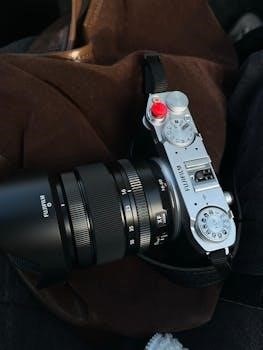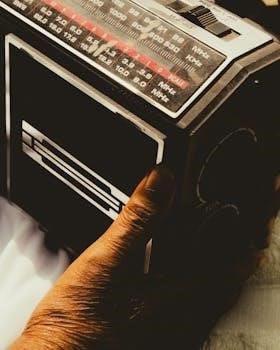Costway Portable Air Conditioner Manual⁚ A Comprehensive Guide
This guide provides a detailed overview of Costway portable air conditioner manuals. These manuals contain vital information about safety, operation, and maintenance. They are essential for understanding the specific features of each model. They also cover important safety precautions and troubleshooting tips.
Costway portable air conditioners offer convenient cooling solutions for various spaces, providing an alternative to traditional window units. These units are designed for ease of use, featuring multiple modes such as cooling, dehumidifying, and fan-only operation. They come in different BTU ratings, catering to rooms of various sizes, and are often equipped with features like remote control, timer functions, and sleep modes for enhanced user comfort. Costway ACs are designed to be moved easily between rooms, making them a versatile cooling option. These air conditioners are ideal for those who need a flexible and straightforward cooling solution without the hassle of permanent installation. They often include safety features such as child lock, overflow, and overload protection. Many models also offer both manual and continuous drainage options, providing flexibility in water management. With various models available, understanding the specific features and specifications of your Costway AC is key to optimal performance and safety. The manuals are therefore essential for effective use and maintenance of your Costway air conditioner.
Key Features of Costway Portable AC Units
Costway portable air conditioners come equipped with a range of features designed for user convenience and effective cooling. Many models offer multiple operating modes including cooling, dehumidifying, and fan-only, allowing for versatile climate control. They often feature adjustable fan speeds to suit different preferences and quick cooling capabilities that can bring a room down to a comfortable temperature efficiently. A built-in timer function, typically ranging from 1 to 24 hours, allows for scheduled operation, while a sleep mode ensures quiet and comfortable use during the night. Units are frequently controlled through an LED touch panel and include a remote for convenient operation from across the room. Safety features like child locks and overflow protection are standard on many models. In addition, they provide both manual and continuous water drainage options for ease of maintenance. The portability is also enhanced by carry handles and universal wheels for easy movement between rooms. These features are carefully designed to provide a user-friendly and effective cooling experience.
Understanding Model Numbers and Specifications
Costway portable air conditioner model numbers, like FP10343US or EP24619US, are crucial for identifying specific unit features and specifications. These numbers help differentiate between models with varying cooling capacities, measured in BTUs (British Thermal Units), such as 8000 BTU or 10000 BTU. The model number also indicates other key specifications, such as the unit’s voltage, typically 115V, and frequency, usually 60Hz. Additionally, the specifications outline the unit’s coverage area, for example, rooms up to 230 sq. ft. or 400 sq. ft. Some models include additional features, like dual hose systems or specific safety protections. Understanding the model number allows you to find the correct user manual, which contains detailed information on features, operation, and maintenance. This information is essential for selecting the right air conditioner for your specific needs and ensuring its proper use. Always refer to the user manual for detailed specifications before operating the unit.
Safety Precautions and Important Information
Costway portable air conditioner manuals emphasize several critical safety precautions. It’s vital to read all instructions carefully before operating the unit. Ensure the air conditioner is used on a stable, level surface to prevent tipping. Keep the unit away from water sources and areas with high humidity to prevent electrical hazards. Check the power cord and plug regularly for damage; never use a damaged cord. Always unplug the air conditioner before cleaning or performing maintenance. Do not obstruct air vents or openings. The manuals also highlight safety features like child lock, overflow protection, and overload protection. Ensure these safety mechanisms are functioning correctly. Avoid using extension cords unless absolutely necessary, and if used, ensure they are rated for the unit’s power requirements. Proper grounding is essential for safe operation. These precautions ensure safe and efficient use of your Costway portable air conditioner, minimizing potential risks and extending the unit’s lifespan.
Initial Setup and Installation Guide
The initial setup of your Costway portable air conditioner is crucial for optimal performance. Begin by carefully unpacking the unit and verifying all components are present, referring to the parts list in the manual. Position the air conditioner near a window for proper ventilation. Attach the exhaust hose to the unit and window adapter, ensuring a secure fit without kinks. The window kit should be properly installed to prevent hot air from re-entering the room. Ensure the hose is not blocked or excessively long, which can hinder cooling efficiency. Check that the unit is on a level surface to avoid issues with water drainage. Before powering on, allow the unit to stand upright for at least 24 hours to ensure the refrigerant has settled. Connect the power cord to a grounded outlet. Follow all instructions in the manual to ensure proper setup and avoid any malfunctions. A correct initial setup will contribute to your unit’s cooling effectiveness and longevity.
Operating Modes⁚ Cooling, Fan, and Dehumidifier

Costway portable air conditioners typically offer three primary operating modes⁚ cooling, fan, and dehumidifier. The cooling mode uses refrigerant to lower the room temperature and usually has adjustable settings. The fan mode circulates air without cooling, offering a breeze for ventilation and comfort. This mode is excellent for energy saving when you don’t need to lower the temperature significantly. The dehumidifier mode removes excess moisture from the air, making the room more comfortable, especially in humid conditions. This function is independent of the cooling cycle. To use a specific mode, select it via the control panel or remote. Each mode is designed to suit different needs and conditions. Check your specific model’s manual for detailed information about each mode’s performance. Understanding these modes helps you use your air conditioner effectively and efficiently, optimizing your comfort while saving energy. The manual will detail any nuances in the operation of these modes.
Using the Control Panel and Remote
Costway portable air conditioners come equipped with a control panel and a remote control for ease of operation. The control panel, usually located on the unit, features buttons or a touch interface to manage settings like mode, fan speed, and temperature. The LED display provides feedback on the selected parameters. Remote controls offer similar functionality, often with added convenience from a distance. The remote allows users to change settings without needing to reach the unit. Both control methods are designed to be intuitive but familiarize yourself with the specific layout and buttons through your manual. Some models feature a child lock on both the control panel and remote for safety. Ensure you have a clear line of sight between the remote and the unit for proper function. The manual will describe the specific functions of each button and the display indicators for your model. Refer to the manual for any specific instructions regarding the remote control battery replacement. Proper use of these controls is essential for optimal performance.
Timer and Sleep Mode Functionality
Costway portable air conditioners often include timer and sleep mode functions to enhance user comfort and energy efficiency. The timer function allows you to set the unit to turn on or off at a specified time, enabling you to cool your space before you arrive or shut it down automatically. This feature can be programmed through the control panel or remote, typically with adjustable increments. Sleep mode is designed to provide a more comfortable sleeping environment. It gradually increases the temperature while the unit operates, preventing overcooling and saving energy. This mode also reduces fan speed and noise levels for undisturbed sleep. The specific steps for setting the timer and sleep modes can vary by model, so it’s essential to consult your user manual. The manual details the correct button sequences for these functions and explains any additional features. These modes provide convenience and improve the overall user experience, making the air conditioner more adaptable to your needs. Familiarizing yourself with these features is recommended for optimal performance and comfort.
Water Drainage⁚ Manual and Continuous
Costway portable air conditioners typically offer two methods for water drainage⁚ manual and continuous. Manual drainage involves collecting the condensed water in an internal tank and emptying it when full. The unit will usually indicate when the tank is full, often with a light or an audible signal. To empty the tank, carefully remove it, pour the water out, and replace it. Continuous drainage, on the other hand, uses a drain hose connected to the unit to allow water to flow out by gravity. This method is more convenient for extended use, as it eliminates the need to frequently empty the water tank. Connecting the drain hose usually involves attaching it to a designated outlet on the back of the unit and placing the other end in a drain or suitable container. The user manual provides specific instructions on how to connect the hose and where to position it for optimal drainage. It’s important to choose the correct drainage method based on your needs and to follow the instructions in the manual carefully to avoid leaks and ensure proper operation. Regular monitoring of the chosen drainage method will ensure efficient and effective performance.

Troubleshooting Common Issues
Costway portable air conditioners, while generally reliable, may encounter occasional issues. Common problems include the unit not cooling effectively, which could be due to blocked air filters needing cleaning, insufficient refrigerant or incorrect settings. The unit might also shut off intermittently; this could be a result of overheating, a full water tank, or issues with the power supply. If the air conditioner makes unusual noises, it might indicate loose parts or a problem with the fan. Another potential issue is the unit not turning on at all, which could be due to a blown fuse or a faulty power cord. The remote control might also fail to work if the batteries are depleted. The user manual provides a comprehensive troubleshooting section that addresses these and other issues. It typically offers step-by-step instructions on how to identify and resolve each problem, including checking connections, cleaning filters, and resetting the unit. If the troubleshooting steps in the manual don’t resolve the issue, it may be necessary to contact customer service for further assistance or repair;

Cleaning and Maintenance Tips
Regular cleaning and maintenance are crucial to ensure the longevity and optimal performance of your Costway portable air conditioner. Begin by always disconnecting the unit from the power source before performing any cleaning tasks. The air filter should be cleaned every two weeks, or more frequently if used in dusty conditions, to prevent reduced airflow and cooling efficiency. Gently wash the filter with mild soap and water and let it dry completely before reinstalling it. The exterior of the unit can be wiped down with a damp cloth. Avoid using harsh chemicals or abrasive cleaners. Inspect the water drainage system regularly to prevent clogs and ensure proper drainage. If the unit has a manual drainage system, empty the tank frequently to prevent overflow. For continuous drainage, check the hose for any blockages. At the end of the season, thoroughly clean the unit and store it in a dry place, preferably covered with a protective sheet. By adhering to these simple cleaning and maintenance tips, you can ensure your Costway portable air conditioner operates efficiently and lasts for years.
Finding and Downloading Manuals Online
Locating the correct manual for your Costway portable air conditioner is essential for proper operation and maintenance. Start by visiting the official Costway website, where you can usually find a dedicated section for product support or manuals. Look for a search bar or a product category that will allow you to find your specific model number, which is typically located on a sticker on the back or side of the unit. Once you find the correct product page, the manual should be available for download in PDF format. If the official site doesn’t have the manual, try searching online using the model number along with the terms “user manual” or “instruction manual.” Websites like ManualsLib or other online manual repositories may have archived copies. Be careful when downloading from third-party sites, ensuring they are reputable to avoid malware. Always confirm the manual you download matches your exact model number to guarantee accuracy. If you still have trouble, contact Costway customer support for assistance.

